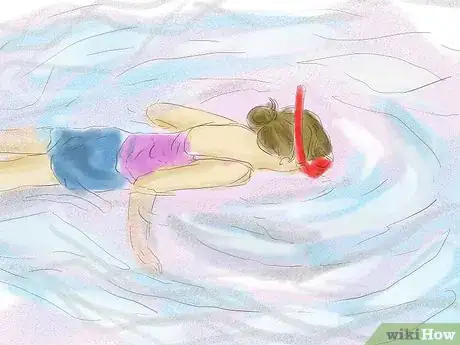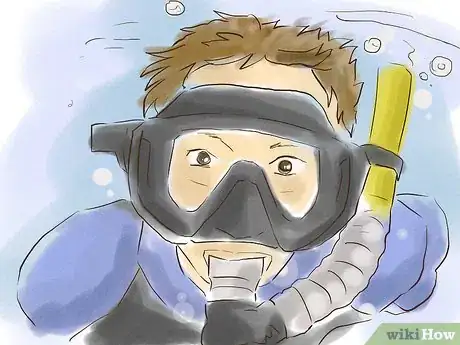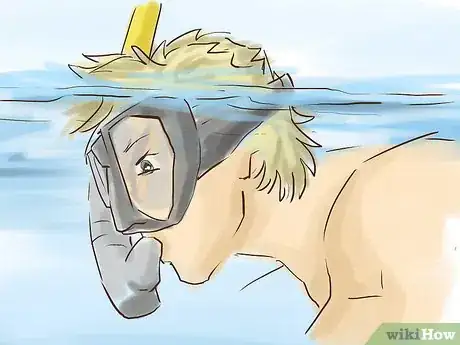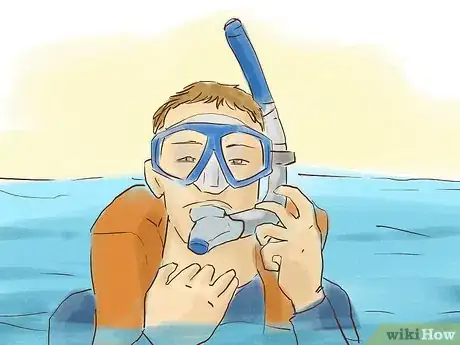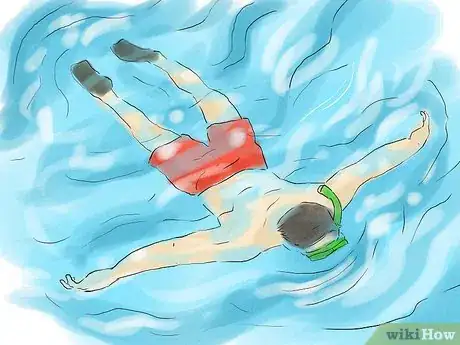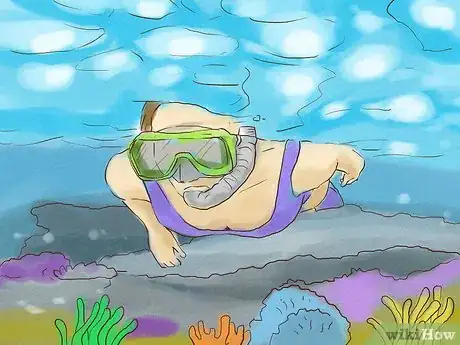wikiHow is a “wiki,” similar to Wikipedia, which means that many of our articles are co-written by multiple authors. To create this article, 26 people, some anonymous, worked to edit and improve it over time.
There are 9 references cited in this article, which can be found at the bottom of the page.
wikiHow marks an article as reader-approved once it receives enough positive feedback. This article received 15 testimonials and 95% of readers who voted found it helpful, earning it our reader-approved status.
This article has been viewed 529,311 times.
Learn more...
Snorkeling is a fun and relaxing way to view the colorful and fascinating world just beneath the ocean's surface. Snorkelers use a clear plastic mask and a short tube to breathe while floating face-down on the surface of the water. This way you can observe coral and marine life without scaring them away the fish with your movements and without having to come up for air every minute. Just floating and being immersed within the underwater scenery is enough to escape the hurdles we encountered in every day life.
Steps
Getting Started
-
1Get a snorkel and mask you feel comfortable with. Try them on and adjust the straps until it fits. If you can, try them on in the water to make sure there are no leaks.[1]
- If you have bad eyesight, consider getting a prescription-adjusted mask to help you see underwater without your glasses or using contact lenses. Disposable ones are great for snorkelling in.
-
2Put on the mask and tug the straps until it feels comfortably sealed around your eyes and nose. Make sure the snorkel tube is close to your mouth, but don't put it in yet.Advertisement
-
3Lay flat in the water on your stomach. Place your face in the water at about a 45 degree angle.[2]
-
4Bite gently down on the mouthpiece of the snorkel. Allow your lips to seal around it and hold the snorkel in place.
-
5Take slow, regular breaths in and out through the tube. Breathe slowly, deeply and cautiously with your mouth through your snorkel. No need to panic: you can always lift your head above water if you want. Just relax and become aware of your breaths. The sound of your breathing through the snorkel barrel should become quite noticeable. Once you get into a rhythm, relax and enjoy the underwater scenery.[3]
-
6Wear a buoyancy vest. This makes floating on the surface of the water with minimal effort much easier. Many commercial snorkeling locations require a colorful life vest to be worn for safety reasons.[4]
Learning to Keep Your Airway Clear
-
1Breathe cautiously. On any snorkeling adventure you are bound to get some water in your tube at some point, sometimes either due to surf conditions or excessive splashing, or by letting your head dip too low in the water. Learning to clear your snorkel will keep this from being a cumbersome disruption to your experience.
-
2Hold your breath and place your head below the water, submerging the end of the snorkel. You should feel that water is entering the snorkel barrel.
-
3Surface your head without lifting it out of the water. Make sure the end of the tube is in the air this time.
-
4Exhale through your mouth quickly and forcefully into the snorkel. This blast method of snorkel clearing will remove nearly all the water from your snorkel.
-
5Expel any remaining amount of water with a second forceful blast. By repeating the blast method you should clear any water that enters into the snorkel.
-
6Master airway control. Sometimes you will get water in your tube when you have no air in your lungs. If there is only a little water, inhale slowly and carefully without letting water into your mouth until you have enough air for a full blast. If there is too much, you will need to lift your head out of the water and take a breath around the mouthpiece.
-
7Learn to dive. Once you get adept at clearing your airway, you can consider diving below the surface of the water to get a better look at something nifty. Take a deep breath and swim down. When you need a breath, surface, keeping your face underwater, and clear your flooded snorkel tube like you practiced.
Swimming with a Snorkel
-
1Use fins on your feet. Wearing fins will amplify your movements and let you move forward quickly without a lot of disruptive splashing.
-
2Hold your arms at your sides to reduce drag and extend your legs so that the fins are pointed behind you. Keep your legs fairly close together.
-
3With your knees slightly bent, kick slowly and powerfully with the fins. Keep your fin stroke movements smooth and relaxed. Try to move from the hip to make use of your thigh muscles and avoid kicking with your knees, as this will only waste your energy.[5]
-
4Kick farther down and less upwards whilst arching your back upward. The right snorkeling technique to power yourself forward with the downward strokes.
-
5Keep your fins below the water when kicking. Try to avoid splashing, as this will scare off the fish and can be annoying to other swimmers around you.
-
6Float with the waves. Snorkeling is best done on gentle waters, but even there you should learn to adjust your movements to the up and down surging of the waves.
-
7Swim at a steady comfortable pace to conserve your energy. Snorkeling is not a race, and a good session can last for hours.
Having a Good Snorkel Experience
-
1Pick the right spot. You want to snorkel in an area that has relatively calm waters and a vibrant mix of benign marine life. Shallow waters above coral reefs are great, as are some deeper spots best accessed by boat. Ask locals or check guidebooks to find the best spots that aren't too full of other swimmers.[6]
-
2Go out on a sunny day. Even with a mask it's hard to see much underwater if the sky is dark and gloomy. Snorkel in the middle of a bright day when the water is clear of silt. Storms tend to churn up silt that clouds the water, so if it rained last night you may want to put your adventure off by a day.
-
3Learn to recognize different fish and coral. Seen one fish, seen them all? Not if you know what you are looking at. Memorize the shapes and colors of different kinds of fish that inhabit your local beaches and you can turn your simple swim into an aquatic zoological survey. If you see a fish you don't recognize, try to remember its patterns and look it up later.
Community Q&A
-
QuestionWhat if I have a phobia of seeing fish underwater?
 Community AnswerThen snorkeling probably isn't the best activity for you.
Community AnswerThen snorkeling probably isn't the best activity for you. -
QuestionCan a beginner swimmer snorkel?
 Community AnswerYes, but start in shallow waters as you get used to it.
Community AnswerYes, but start in shallow waters as you get used to it. -
QuestionWhere can I buy a buoyancy vest?
 Community AnswerThere are many places online, as well as in pool shops.
Community AnswerThere are many places online, as well as in pool shops.
Warnings
- Be aware of where you are. Following some sparkling fish it can be easy to find that you have paddled further out to sea than you had planned. Avoid dangerous situations by being mindful of how far you've gone.⧼thumbs_response⧽
- Being in the ocean is never truly safe. It is possible to encounter sharks, stinging jellyfish and other dangerous marine animals even in highly touristed snorkel spots. There are also riptides that can tear you out into open water and large waves that can dash you against sharp rocks. Make sure you are confident in your swimming abilities and never go snorkeling alone.⧼thumbs_response⧽
- Avoid hyperventilating. Slow, steady breathing is the key to snorkeling. Hyperventilating with a snorkel can make you pass out in the water—clearly a dangerous prospect.[9]⧼thumbs_response⧽
- Stay hydrated. You can lose a lot of water in the sea. If you plan to snorkel for hours, make sure you take breaks to get a drink. Whatever you do, don't drink salt water.[10]⧼thumbs_response⧽
Things You'll Need
- 1 diving mask
- 1 snorkel tube
- 1 pair of fins
- A swimsuit, or a wetsuit for cooler waters
- Sunblock
References
- ↑ https://www.allaboutvision.com/sports/diving.htm
- ↑ http://www.seafriends.org.nz/school/snorkel.htm
- ↑ https://aquaworld.com.mx/en/blog/some-of-the-best-snorkeling-tips-for-beginners
- ↑ http://nwdistrict.ifas.ufl.edu/nat/tag/snorkeling/
- ↑ https://sailhawaii.com/faqs/how-to-snorkel/
- ↑ https://www.adventureinyou.com/travel-tips/beginners-guide-to-snorkeling/
- ↑ http://www.secore.org/site/our-work/detail/sustainable-under-water-protect-coral-reefs.31.html
- ↑ http://nwdistrict.ifas.ufl.edu/nat/tag/snorkeling/
- ↑ https://www.ncbi.nlm.nih.gov/pmc/articles/PMC1114047/
About This Article
To snorkel, start by putting on your mask and tightening the straps until it's snug. Then, lay flat in the water on your stomach so your face is submerged. Next, gently bite down on the snorkel's mouthpiece and seal your lips around it. As you're swimming through the water, breathe normally in and out of the snorkel tube. If any water gets in the tube, just exhale forcefully through your mouth to clear it out. To learn how to dive underwater with a snorkel on, scroll down!


